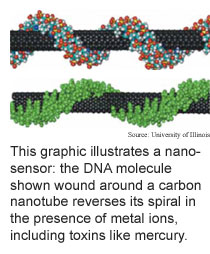
January
30, 2006
DNA-nanotube
combo spots toxins
Medical diagnostics and biomedical research are poised to benefit
from nanosensors that combine DNA's sensitivity to specific substances
and nanotubes' electrical and optical sensitivity to the environment.
 Researchers from the University of Illinois at Urbana-Champaign
have developed a DNA-nanotube sensor
that detects metal ions in blood, tissue and even within cells. The presence
of ions alters the DNA, which in turn alters the infrared emission of
the nanotube.
Researchers from the University of Illinois at Urbana-Champaign
have developed a DNA-nanotube sensor
that detects metal ions in blood, tissue and even within cells. The presence
of ions alters the DNA, which in turn alters the infrared emission of
the nanotube.
The sensors consist of double-stranded DNA helixes wrapped around
semiconducting, single-walled carbon nanotubes. When ions, or atoms with
one or more extra or missing electrons, are present the DNA helixes separate,
then reform with the spiral in the opposite direction. This change alters
the electronic structure of the nanotubes, which can be detected as a
dimming of their infrared fluorescence.
The researchers tested the sensor by causing living cells to absorb
DNA-wrapped nanotubes, then mercury ions. The nanotubes' infrared emission
dimmed in proportion to the amount of mercury ions the cells had absorbed,
and returned to its normal level when the ions were removed.
The sensor could be used to detect contaminants and for research
into why DNA helixes sometimes reverse.
(Optical Detection of DNA Confirmational Polymorphism on Single-Walled
Carbon Nanotubes, Science, January 27, 2006)
Self-improving software
If people are expected to learn on the job, why isn't software?
Although some kinds of software are capable of learning, it's more difficult
to design software that learns as it works without requiring a separate
training process.
Princeton University researchers have designed algorithms
-- the logic underlying software -- that learn from data that they don't
know anything about ahead of time and then tune themselves to better handle
those types of data. The key is that the algorithms learn from how the
pieces of data fit within the range of possibilities, rather than having
to learn the data's details.
It turns out that even though any given piece of data is random,
individual pieces fall into relatively narrow ranges that an algorithm
can learn from. An algorithm can also improve after learning from a relatively
small number of samples.
The researchers built two self-improving algorithms, a sorting
algorithm and a clustering algorithm. Sorting algorithms put pieces of
data into some type of order and clustering algorithms group like pieces
of data.
The algorithms promise to be forerunners of software that alters
its default configuration on its own as it learns how it is used.
(Self-Improving Algorithms, ACM-SIAM Symposium on Discrete Algorithms,
January 22-24, 2006, Miami, Florida)
Bits and pieces
Detector boosts quantum crypto
A quantum
cryptography system that includes high-efficiency superconducting
photon detectors transmits secure messages over 50 kilometers of optical
fiber at standard telecommunications wavelengths.
(Quantum Key Distribute Telecom Wavelengths with Noise-Free Detectors,
Applied Physics Letters, January 9, 2006)
Self-assembly makes flexible LCD
A fabrication process
causes liquid crystal to embed itself in a polymer to make flexible liquid
crystal displays. The screens are potentially inexpensive because they
use one surface instead of the usual sandwich of components.
(Single-Substrate Cholesteric Liquid Crystal Displays by Colloidal
Self-Assembly, Applied Physics Letters, January 23, 2006)
Graphics chips speed holograms
A study
shows that processing computer-generated holograms on a graphics processing
unit (GPU) is much faster than using a central processing unit (CPU).
Computer-generated holograms are require a lot of computer power; making
them faster is a key step toward three-dimensional television.
(Computer-Generated Holography Using Any Graphics Processing Unit,
Optics Express, January 23, 2006)
Nanorods focus microscope
A proposed imaging
system uses hexagons made from 50- by 20-nanometer silver nanorods
instead of lenses to make optical microscopic images that focus on objects
as small as 40 nanometers. A nanometer is one millionth of a millimeter.
This is far smaller than ordinary optical microscopes and comparable to
near-field imaging systems, which use probes in extremely close proximity
to a sample.
(Subwavelength Optical Imaging through a Metallic Nanorod Array,
Physical Review Letters, December 31, 2005)
RSS Feeds: News Blog Books New: TRN's Internet Services TRN's Jobs Center News: Research News Roundup Research Watch blog Features: View from the High Ground Q&A How It Works Buy an ad link |
|
| Advertisements: |
|
Ad links: Clear History
Buy an ad link
|
TRN
Newswire and Headline Feeds for Web sites
|